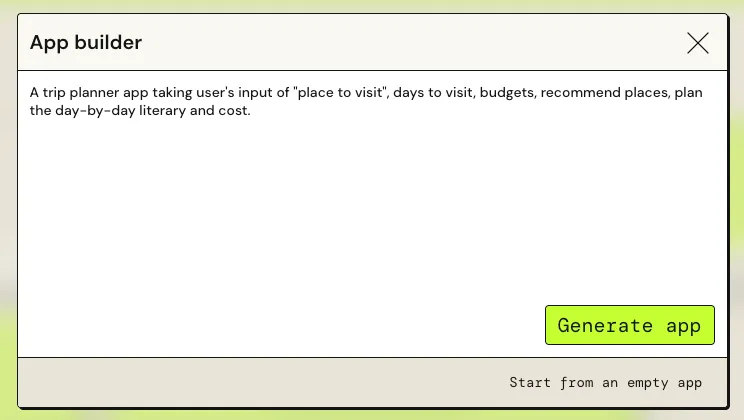Transforming Generative AI Idea into Reality with AWS PartyRock in Just 20 Minutes
This article described how to use AWS PartyRock to create a trip planner app.






- Points of interest
- Detailed itinerary
- Estimated costs
- Crucial advice regarding weather, safety, necessary travel documents, parking, currency, and language
- Recommendations for music and movies related to the destination

1
2
3
4
5
6
7
8
9
10
11
12
13
14
15
16
17
18
19
20
21
22
23
24
25
26
27
28
29
30
31
32
33
34
35
36
37
38
39
40
41
42
43
44
45
46
47
48
49
50
51
52
53
54
55
56
57
58
59
60
61
62
63
64
65
66
67
68
69
70
71
72
73
74
75
76
77
# Trip to Las Vegas and National Parks
## Places to Visit
### Las Vegas
- The Las Vegas Strip — Famous for its hotels, casinos, restaurants, and nightlife. Great place to experience the bright lights of Vegas.
- Fremont Street — Historic downtown area with classic Vegas neon signs. Fun place to explore.
- Red Rock Canyon — Beautiful desert landscape just outside the city. Great for hiking and taking in natural beauty.
### Utah
- Zion National Park — Incredible rock formations and canyon landscapes. Hiking trails with amazing views.
- Bryce Canyon National Park — Famous for its unique geological rock structures. Breathtaking vistas.
- Arches National Park — Home to over 2,000 natural sandstone arches. Striking natural beauty.
### Arizona
- Grand Canyon National Park — The granddaddy of them all. Jaw-dropping views into the massive canyon.
- Antelope Canyon — Stunning and narrow slot canyon famous for its beams of light. Photographer’s paradise.
- Horseshoe Bend — Dramatic horseshoe shaped curve in the Colorado River. Iconic viewpoint.
### Nevada
- Valley of Fire State Park — Bright red Aztec sandstone formations. Great for hiking and photography.
- Lake Mead National Recreation Area — Massive reservoir with opportunities for water sports. Scenic nature.
## Itinerary
Since we have a larger group, I recommend flying to maximize time and reduce driving.
**Day 1** — Fly into Las Vegas. Explore Las Vegas Strip. Overnight in Las Vegas.
**Day 2** — Visit Red Rock Canyon. Drive to Zion National Park. Hike and explore. Overnight near Zion.
**Day 3** — Hike more of Zion. Drive to Bryce Canyon. Overnight near Bryce.
**Day 4** — Explore Bryce Canyon. Drive to Page, AZ. Visit Antelope Canyon. Overnight in Page.
**Day 5** — See Horseshoe Bend. Drive to Grand Canyon. Explore Grand Canyon. Overnight near Grand Canyon.
**Day 6** — More exploring of Grand Canyon. Drive back to Las Vegas. Overnight in Las Vegas.
**Day 7** — Visit Valley of Fire State Park on drive back to Las Vegas. Depart Las Vegas.
## Cost
- Flights: $1000 roundtrip for 4 people
- Rental Car + Gas: $600
- Hotels: $700 total ($100 per night average)
- Park Entry: $280 ($35 per vehicle for 7 days)
- Food: $1200 ($50 per person per day)
- Activities: $500
- Total = Around $5000
## Tips
- June is very hot in the desert. Make sure to drink plenty of water and protect against sun exposure.
- Watch out for wildlife like snakes and scorpions in natural areas.
- Bring good hiking shoes/gear for exploring parks.
- Carry sunscreen, hat, sunglasses for sun protection.
- Some parks may require reservations for camping, hotels, or certain activities. Book in advance.
- Make sure your ID is current as some parks border Arizona state lines.
- US dollars are used in all locations. English is commonly spoken.
- Fill up gas when you see a station since they can be sparse in remote areas.
## Enjoy the Trip
- Make some road trip playlists with classics like “Take It Easy” by The Eagles or “I Love a Rainy Night” by Eddie Rabbitt.
- Queue up national park documentaries like Ken Burns’ The National Parks to get excited about the destinations.
- Sing along to “Viva Las Vegas” by Elvis Presley when arriving in Vegas.
- Don’t forget the snacks! Trail mix, beef jerky, and crackers are great road trip foods.
I hope you have an amazing trip filled with natural beauty and making lasting memories! Wishing you safe travels, good weather, and a rejuvenating time enjoying the great outdoors. Enjoy every sunrise, sunset, and awe-inspiring view.- Video: https://youtu.be/irgli9_nGOs
- Learning Planner app: App Link, Video Link
- Recipe Generator app: App Link, Video Link
- AWS PartyRock: https://partyrock.aws/
